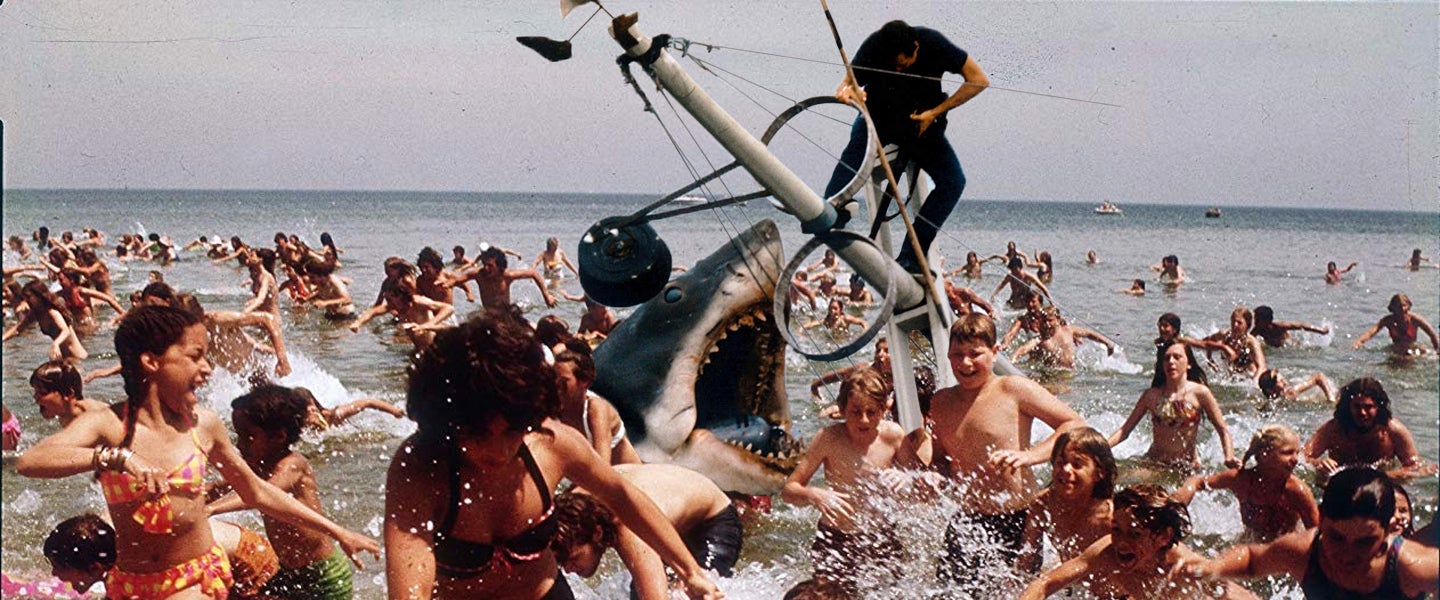Forty-four years after its initial release, Jaws is still in the water. It’s not just that it eventized summer as a movie-going experience by getting the public off the beach to hang out inside a theater to, ironically, see a movie about hanging out at the beach (as the story goes, national beach attendance instantly suffered). It’s that in many ways, Jaws is the quintessential summer movie, and an extremely American one at that: It’s a 1970s beach flick about a freakishly focused shark that takes place on the Fourth of July weekend and opens with some tiddies.
As a quick refresher for the uninitiated (it has, after all, been nearly half a century), the film is set in a town called Amity, a fictional beachy tourist town that depends completely on the summer money grab to survive. When a great white attacks a girl, it shakes up Amity enough to cause alarm in police chief Brody (Roy Scheider), a New York transplant and family man who escaped the crime-ridden scum of the city to this place, and who happens to also hate the water. He’s talked out of his concern because of the town’s fear of scaring the summer crowd away, but when more and more bodies start piling up, he soon realizes that New York crime can’t hold a candle to Amity’s menace.
That’s when Hooper (Richard Dreyfuss), a nerdy oceanographer from a wealthy family, is called in to study this thing. And when the townsfolk prove themselves outrageously ill-prepared to rumble with an inexplicably vindictive shark, Brody hires Quint (Richard Shaw), a hardscrabble sea captain who’s long on adventures but running short on sanity, who promises to deliver the whole damn thing for $10,000.
Make no mistake, this is a horror movie that gets to have it every way it pleases. It inspires a gripping fear of sharks that many people still irrationally hold to this day, while also sitting comfortably in the shlock of a big mechanical shark swallowing up men, women and children with ruthless abandon. It invokes our most positive associations with the beach, ocean and our childhood nostalgia for summer vacation, and skillfully reflects it back at us in a funhouse mirror: We all know, it reminds us, that we make a devil’s bargain every time we enter the water, because we have no idea what the hell is really lurking out there.
Keep in mind, The Exorcist has been released 18 months earlier, but as Roger Ebert noted in his review at the time, Jaws is just as frightening, but nicer. That’s important for a family summer flick, because it still feels like real people, albeit real people dealing with an outrageously unbelievable problem. It does that by somehow never taking itself too seriously.
In the meantime, it also doubles as a credible exploration of masculinity that points obviously enough to Moby Dick’s central tension without ever putting on airs about it. In the film’s second half, Brody, Hooper and Quint head out in a beaten-up trawler, Orca, to track the shark. And in a pivot that suddenly feels almost like a different film, we now see three generations of men, from three different classes, with three different takes on American masculinity: The stoic (Quint), the level-headed family man (Brody) and the beta nerd (Hooper). Their values clashes, begrudging granting of respect and eventual bonding is the backdrop to their internal struggle with fear, and ultimately, what it means to each of them to be a man.
Remember, they’re battling a giant, mechanical shark. But what’s just as fun is seeing the tension in all three versions. There’s no doubt that Quint’s version has expired by today’s standards, but unexpectedly, Brody and Hooper, at least in terms of realistic vulnerability, manage to far surpass today’s ideal by a mile. That depth is why the film remains more than just a template we’ve built summer blockbuster marketing on top of, but the bones of the movies themselves.
And the pervasive presence in our psyche remains, even decades later. For example, earlier this year cage diver and underwater photographer Euan Rannachan snapped this photo of a great white shark off the coast of Mexico in a perfect recreation of the original movie poster:
Cities across the country are also dusting off the reel to host their annual Jaws screenings. The award for most creepily fitting goes to the city of Escambia, Florida, who sold out two nights in June on the Santa Rosa Sound where moviegoers will be issued a float and a glowing necklace to watch the film on the water, with their feet dangling in the water. Shark repellent permitted. Because every summer, Jaws still comes for us.

